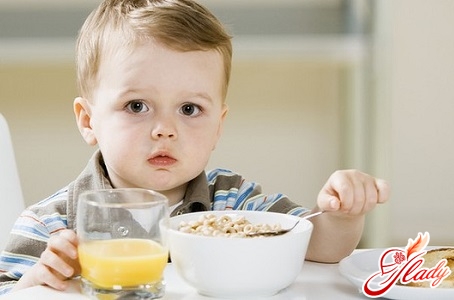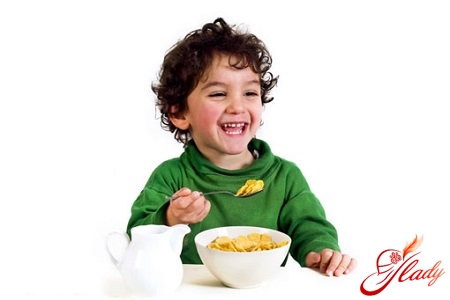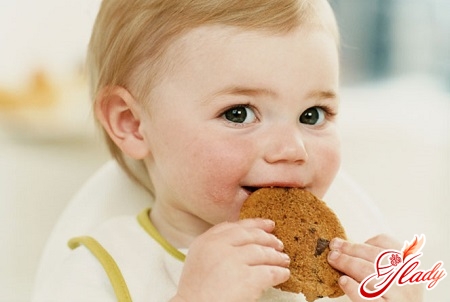
Due to the fact that children grow quite fast anddevelop, young mothers have to adapt all the time. And in the diet of the child, as it grows up, changes occur. With each month the digestive system of the child is improved, the enzymatic activity increases, the taste perception improves, the capacity of the stomach increases (which allows to reduce the number of feedings, while simultaneously increasing the portion). By the end of the first year of life, children already have, as a rule, 6-8 teeth, which allows not only to swallow, but also to chew food. These factors make it possible to diversify the baby's nutrition after a year. And bring the child's food closer to taste, consistency and composition to adults.
Errors in the nutrition of children
Often when feeding children who crossed the yearadults, admit typical mistakes. Some moms of one-year-olds begin to immediately feed them with food intended for adults. Others continue to feed children with puree food up to 2-3 years of age. And in one, and in another case, nutrition will be inferior. The transition from breastfeeding and mushy food to full-grown adult food should be gradual and include "transitional food". Since at the age of 1 to 2 years the chewing apparatus is not yet fully developed (at this age, as a rule, chewing teeth are only beginning to appear), the food should be soft, not hard and dry, but at the same time not be punctured . Meat for children from 1 to 1.5 years give ground, in the form of puddings, steam cutlets. Vegetables and fruits are given finely grated. Older children (when molar teeth begin to sprout) already have a sense of giving food that requires active chewing. 
Basic principles of nutrition
To ensure nutrition of the childthe following principles must be observed. Food should be of high quality, meet caloric needs and provide a daily supply of proteins, fats, carbohydrates, vitamins and mineral salts. Protein is the main building material. At this age, insufficient intake of protein adversely affects the growth and development of the child. The daily intake of proteins at the age of 1-3 years is 30-40 grams per day. At the same time, 2/3 of the proteins should be of animal origin (meat, fish, eggs, dairy products), and a third of the proteins must be of plant origin (nuts, beans). Fats are one of the sources of energy. With them, vitamins A, D, E and K are received. Easily digestible sources of fats are fish oil, fats contained in egg yolk, milk fats (butter, dairy products). Carbohydrates - are involved in the metabolism of proteins and fats, are easily absorbed by the child's body. The daily norm of carbohydrates at the age of 1-3 years leaves about 130-200 g. The main sources of carbohydrates at this age should be cereals, fruits, vegetables, bread. Care should be taken with sugar, since its overabundance negatively affects a child's health. Vitamins - regulate metabolic processes in the body. Due to the enormous impact they have on the health of the child, it is necessary to pay special attention to the quantity and quality of fruits and vegetables consumed daily by the child (since fruits and vegetables are the main sources of vitamins). And we should strive to ensure that the table of the child was present with vegetables and fruits growing in the region where the child lives, and corresponding to the season. Mineral substances are a building element of cells and tissue fluids, and at the same time they regulate metabolic processes. Mineral substances are contained in plant and animal food, so you need to diversify the diet of the child with these products. Water. The organism of the child after 85% consists of water. The daily requirement of a child in water is about 90 ml. for 1 kg of weight. In addition to water at this age, you can eat compotes, decoction of dogrose, tea, after one and a half years - cocoa. 
What is the child's varied diet?
It can be concluded that the child needsprovide a rich and varied food. It has been scientifically proven that when eating various combinations of foods, individual nutrients are better absorbed. The daily menu of the child should be made up of products that are included in 7 main groups: 1. Milk and dairy products. 2. Meat and meat products, egg fish. 3. Vegetable and milk fats. 4.Bread, flour, cereal. 5. Legumes. 6. Vegetables. 7.Fruit. For the health of the child, it is necessary that the daily diet included products from all 7 groups. However, do not assume that every day you need to use all of the listed products. For example, meat should be excluded 2 times a week. It can be replaced by other products containing animal proteins: eggs, dairy products, fish. This is considered a varied diet. A child at an early age should get used to the variety of foods and flavors, so that there is no taste for only a limited number of foods, since this entails the danger of monotonous and unilateral feeding.
Child's diet after 1 year
The most complete assimilation of nutrients,contained in food, is possible only if the rational diet is observed. It provides a physiologically justified number of feedings during the day, intervals between them. Special scientific research has determined that the intervals between feedings are at least 4 hours optimal for the child's body. If in this interval children receive any other food (sweets, cookies, sweets, milk), then the excitability of the food center is inhibited, and the child loses his appetite for the next feeding. The stomach is also released from the accepted food in no less than 4 hours. At smaller intervals between feeds, the food taken in the previous and the new feeding overflows the stomach, which is very poorly reflected in digestion. Young children are recommended to observe a 4-fold feeding regimen, combining it with other regimes (sleep, games, walks). The most suitable mode of nutrition for young children is a regime of 4-fold feeding at a 4-hour interval between feedings and a uniform distribution of food between feedings, both in quantity and in terms of the ratio of essential nutrients (proteins, fats, carbohydrates). Organizational moments When feeding young children, it is necessary to ensure a calm environment, directing the child's attention to food. You can not distract him with conversations, songs, games and forcibly force him to eat the amount of food that you think is optimal for him. At this age, hygiene and cultural skills should be instilled in the child, and the child should be trained to feed on his own. The food of a young child should be prepared from high-quality products. The dishes should be varied, pleasant to the taste and have an attractive appearance, warm, should be served in beautiful children's appliances. All this stimulates the child's appetite. And all that is eaten with appetite and digested much better.









